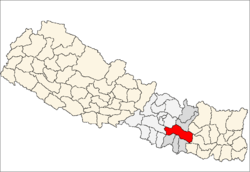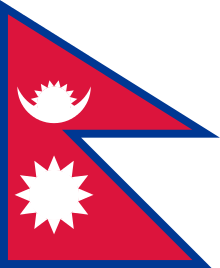Sindhuli District
| Sindhuli सिन्धुली | |
|---|---|
| District | |
 | |
| Country | Nepal |
| Region | Central (Madhyamanchal) |
| Zone | Janakpur |
| Headquarters | Kamalamai |
| Area | |
| • Total | 2,491 km2 (962 sq mi) |
| Population (2011) | |
| • Total | 296,192 |
| • Density | 120/km2 (310/sq mi) |
| Time zone | NPT (UTC+5:45) |
| Main language(s) |
Nepali,Magar,Tamang,Chepang Newari |
| Website |
www |
Sindhuli District (Nepali: सिन्धुली जिल्ला![]() Listen ), a part of Janakpur Zone, is one of the seventy-five districts of Nepal, a landlocked country of South Asia. The district, with Sindhulimadhi Kamalamai as its district headquarters and covers an area of 2,491 km². In 2001, it had a population of 279,821, in 2011 the population was 296,192.[1][2]
Listen ), a part of Janakpur Zone, is one of the seventy-five districts of Nepal, a landlocked country of South Asia. The district, with Sindhulimadhi Kamalamai as its district headquarters and covers an area of 2,491 km². In 2001, it had a population of 279,821, in 2011 the population was 296,192.[1][2]
Naming
i) Before being annexed as the integral part of Nepal, it was under the governance of Makwani king. During 1530 Raghab Narendra Sen was the King of Makwanpur and was renowned as the Sindhul. He had outseted the settlement over this region. Since then it got the name Sindhuli.[3]
ii) At ancient time the great saint used to dwell in the hill (1077 m from the see level) of nowadays Sindhuli madi. He was popular as Siddha Baba(one who got enlightened)among residents of Sindhuli district.This place got its naming under his name and began to be called as Siddhasthali सिद्धस्थाली (place where enlighten lives). With time it got deviated and began to be pronounced as Sindhuli.
iii) An indigenous group (Tamangs) were predominant in this region. These indigenous people call Singthuwa (सिङ्थुवा) for cutting down tree and Sinthuji (सिङ्थुजी) for collecting timber.Due to the presence of intense forest within this region the herding of goats was popular and way of living was dependent on agriculture and forest resources.Over time due to gradual deviation in the naming this region got its name as Sindhuli.
Historical Importance
This place has a huge historic significance. The Sindhuli Gadhi in Sindhuli is the place where British soldiers were defeated for the first time in Asia in 1767 A.D . The British under the leadership of Captain Kinloch came to help the then ruler of Kathmandu, Jai Prakash Malla against the attack of Prithvi Naraya Shah. The Gurkha soldiers were familiar with the terrain and they utilized it to the fullest. They British Army had advanced weaponry such as guns and cannons whereas the Gurkha were with bows and arrows, spears, etc. But then Gurkhas fought bravely and eventually defeated the British. The British ran for their lives and retreated leaving behind the weapons they brought together with them. Some of these weapons were there to the end of 2005 but know we barely find anything.Though its historically significant place and is gifted with heart touching beauty. Due to the lack of concern its no more than a place caring remains of past and is living with little remnant.
Facts about Sindhuli District
- It is the district that touches many districts together with Makwanpur.
- It is famous for junar production. Because of this, Sindhuli District is also known as junar district.
Geography and Climate
| Climate Zone[4] | Elevation Range | % of Area |
|---|---|---|
| Lower Tropical | below 300 meters (1,000 ft) | 13.7% |
| Upper Tropical | 300 to 1,000 meters 1,000 to 3,300 ft. |
61.7% |
| Subtropical | 1,000 to 2,000 meters 3,300 to 6,600 ft. |
23.6% |
| Temperate | 2,000 to 3,000 meters 6,400 to 9,800 ft. |
0.5% |
Village Development Committees (VDCs)

Prominent People
- Uma Nath Sastri (Sindhuliya)
- Chandra Prakash Gajurel
- Prof. Dr. Suresh Raj Sharma
- Prof. Dr. Lok Bikram Thapa
References
- ↑ Household and population by districts, Central Bureau of Statistics (CBS) Nepal
- ↑ General Bureau of Statistics, Kathmandu, Nepal, Nov. 2012
- ↑ जिल्ला बिकाश समिति,सिन्धुली
- ↑ The Map of Potential Vegetation of Nepal - a forestry/agroecological/biodiversity classification system (PDF), . Forest & Landscape Development and Environment Series 2-2005 and CFC-TIS Document Series No.110., 2005, ISBN 87-7803-210-9, retrieved Nov 22, 2013
